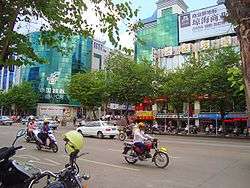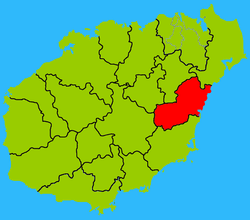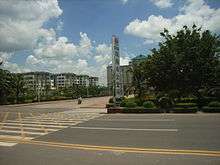Qionghai
Qionghai (simplified Chinese: 琼海; traditional Chinese: 瓊海; pinyin: Qiónghǎi) is one of the seven county-level cities of Hainan province, China. Although called a "city", Qionghai refers to a large land area in Hainan - an area which was once a county. Within this area is the main city, Qionghai City. It is located in the east of the island at the mouth of the Wanquan River, 86 kilometres (53 mi) from the provincial capital of Haikou. It has an area of 1,692 square kilometres (653 sq mi) and in 2010, it had a population of 483,217.
Qionghai 琼海市 | |
|---|---|
County-level & Sub-prefectural city | |
 | |
 Map showing entire Qionghai area within Hainan province | |
| Coordinates: 19°14′35″N 110°27′51″E | |
| Country | People's Republic of China |
| Province | Hainan |
| Township-level divisions | 12 towns |
| Municipal seat | Jiaji (嘉积镇) |
| Area | |
| • Total | 1,692 km2 (653 sq mi) |
| Elevation | 22 m (73 ft) |
| Population (2010) | 483,217 |
| Time zone | UTC+8 (China Standard) |
| Postal code | 571400 |
| Area code(s) | 0898 |
| Licence plates | 琼C |
| Website | http://www.qionghai.gov.cn/ |
The seat of government is at Jiaji (simplified Chinese: 嘉积镇; traditional Chinese: 嘉積鎮; pinyin: Jiājī Zhèn), often now referred to simply as Qionghai. Bo'ao, seat of the Boao Forum for Asia, belongs to Qionghai City.
The former counties of Qiongdong (postal: Kiungtung) and Lehui (樂㑹, postal: Lokwei) are now part of Qiongdong City.
Climate
Qionghai has a tropical monsoon climate (Köppen Am).[1] Monsoonal influences are strong, with a relatively lengthy wet season and a pronounced dry season (January to March). Rainfall is heaviest and most frequent from August to October, when typhoons may strike, and is otherwise still common throughout the year, averaging an annual total of 2,000 mm (79 in); there are 9.3 days with 50 mm (1.97 in) or more of rain. Humidity is consistently very high, with an average relative humidity of 85.8%. With monthly percent possible sunshine ranging from 31% in February to 62% in July, the city receives 2,037 hours of bright sunshine annually; the city receives about only a third of possible sunshine from December thru February, while May thru July is the sunniest time of year.
| Climate data for Qionghai (1981−2010 normals) | |||||||||||||
|---|---|---|---|---|---|---|---|---|---|---|---|---|---|
| Month | Jan | Feb | Mar | Apr | May | Jun | Jul | Aug | Sep | Oct | Nov | Dec | Year |
| Record high °C (°F) | 31.2 (88.2) |
34.7 (94.5) |
33.9 (93.0) |
36.8 (98.2) |
38.8 (101.8) |
39.2 (102.6) |
39.2 (102.6) |
37.2 (99.0) |
36.9 (98.4) |
34.8 (94.6) |
33.5 (92.3) |
30.4 (86.7) |
39.2 (102.6) |
| Average high °C (°F) | 22.8 (73.0) |
24.1 (75.4) |
26.8 (80.2) |
30.0 (86.0) |
32.2 (90.0) |
33.2 (91.8) |
33.3 (91.9) |
32.8 (91.0) |
31.5 (88.7) |
29.2 (84.6) |
26.5 (79.7) |
23.7 (74.7) |
28.8 (83.9) |
| Daily mean °C (°F) | 18.8 (65.8) |
20.2 (68.4) |
22.7 (72.9) |
25.7 (78.3) |
27.6 (81.7) |
28.7 (83.7) |
28.6 (83.5) |
28.1 (82.6) |
27.1 (80.8) |
25.5 (77.9) |
22.7 (72.9) |
19.7 (67.5) |
24.6 (76.3) |
| Average low °C (°F) | 16.1 (61.0) |
17.7 (63.9) |
20.0 (68.0) |
23.0 (73.4) |
24.6 (76.3) |
25.6 (78.1) |
25.5 (77.9) |
25.0 (77.0) |
24.3 (75.7) |
22.8 (73.0) |
20.0 (68.0) |
17.1 (62.8) |
21.8 (71.3) |
| Record low °C (°F) | 7.8 (46.0) |
8.0 (46.4) |
6.3 (43.3) |
14.6 (58.3) |
15.7 (60.3) |
21.0 (69.8) |
22.2 (72.0) |
21.5 (70.7) |
18.8 (65.8) |
13.9 (57.0) |
10.1 (50.2) |
6.3 (43.3) |
6.3 (43.3) |
| Average precipitation mm (inches) | 31.9 (1.26) |
48.4 (1.91) |
55.9 (2.20) |
106.3 (4.19) |
229.8 (9.05) |
166.8 (6.57) |
165.2 (6.50) |
268.6 (10.57) |
361.4 (14.23) |
356.7 (14.04) |
138.3 (5.44) |
70.8 (2.79) |
2,000.1 (78.75) |
| Average rainy days (≥ 0.1 mm) | 10.6 | 11.1 | 10.1 | 12.1 | 15.0 | 14.6 | 12.9 | 17.9 | 17.5 | 16.5 | 13.4 | 10.8 | 162.5 |
| Average relative humidity (%) | 86 | 87 | 86 | 85 | 83 | 82 | 82 | 84 | 85 | 84 | 83 | 83 | 84 |
| Mean monthly sunshine hours | 116.3 | 101.6 | 150.3 | 181.4 | 219.3 | 225.3 | 251.4 | 215.4 | 179.8 | 162.5 | 121.1 | 112.2 | 2,036.6 |
| Percent possible sunshine | 34 | 31 | 41 | 48 | 55 | 57 | 62 | 54 | 49 | 45 | 36 | 33 | 46 |
| Source: China Meteorological Administration (precipitation days and sunshine 1971–2000),[2][3] | |||||||||||||
Administrative divisions
Qionghai is divided into 12 towns:[4]
|
Other

Qionghai is historically associated with the Red Detachment of Women, an all-female company of the Chinese Red Army who survived Nationalist persecution. A novel based on their story has been made into a ballet (The Red Detachment of Women) and two films.
The most famous dish of Qionghai is Jiaji Duck, originally introduced to Qionghai by locals who returned from living in Southeast Asia.
References
- Peel, M. C. and Finlayson, B. L. and McMahon, T. A. (2007). Updated Asian Map of the Köppen climate classification system. Hydrol. Earth Syst. Sci. 11: 1633-1644.
- 中国气象数据网 - WeatherBk Data (in Chinese). China Meteorological Administration. Retrieved 2020-04-15.
- 中国地面国际交换站气候标准值月值数据集(1971-2000年). China Meteorological Administration. Archived from the original on 2013-09-21. Retrieved 2010-05-25.
- 2011年统计用区划代码和城乡划分代码:琼海市 (in Chinese). National Bureau of Statistics of the People's Republic of China. Archived from the original on 2012-07-03. Retrieved 2013-02-10.
